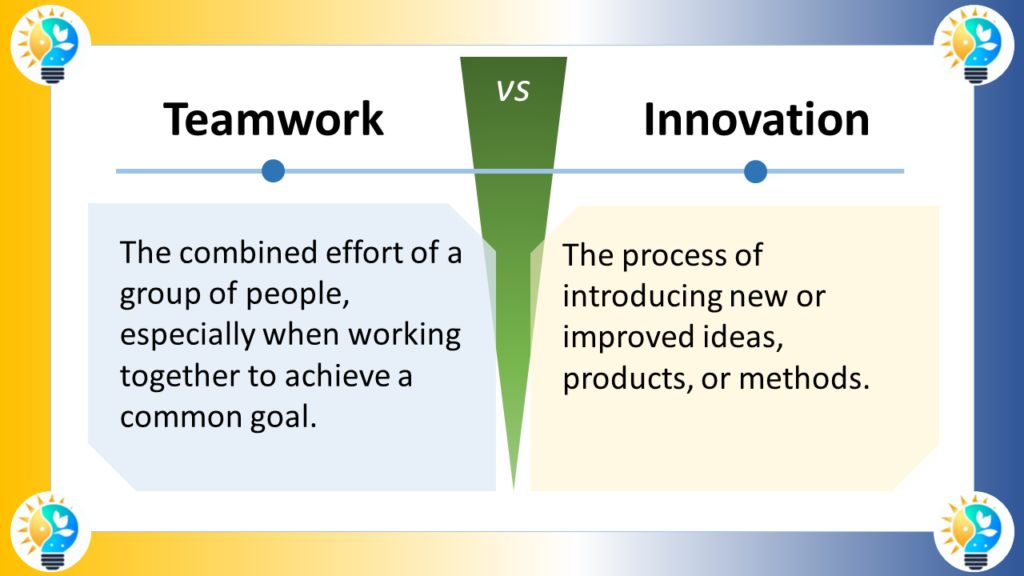Initiating involves starting something new, while innovating involves improving upon existing ideas. Initiating is often a one-time event, while innovating is an ongoing process.

Initiate vs. Innovate: Understanding the Relationship
Initiate and innovate are two terms that are often used interchangeably, but they have distinct meanings and functions.
While both terms are related to starting something new, they differ in their scope, focus, and impact.
Defining Initiate and Innovate
Initiate refers to the act of starting or beginning something. It involves taking the first step towards a goal or objective. Initiation requires a certain level of boldness and courage, as it often involves stepping into the unknown and taking risks. Initiating can also involve taking on a leadership role and setting the direction for a team or project.
Innovate refers to the process of introducing something new and different. Innovation involves creativity, critical thinking, and problem-solving skills. It goes beyond simply starting something new and focuses on creating value by improving existing processes or developing new ones.
The main difference between “innovate” and “initiate” lies in their meanings and usage.
“Innovate” refers to making changes or doing something in a new way, introducing new ideas or methods, and implementing novel and useful concepts or approaches.
On the other hand, “initiate” means to begin or start something, to take the first steps in a process, or to introduce something, often used in the context of starting a particular action or procedure.
According to Merriam-Webster, “innovate” means “to make changes: do something in a new way” and “to introduce as or as if new”. In the context of innovation, it involves the utilization of a novel idea or method, introducing fresh concepts or approaches to the market, and transforming existing inventions into products that attract customers and generate value.
On the other hand, “initiate” is defined as “to begin or start (something)”. In the context of initiation, it is about taking the first steps in a process, introducing something, or starting a particular action or procedure.
More Synonyms on innovation, innovate and innovative:
- Adapt
- Advance
- Change
- Create
- Cultivate
- Devise
- Develop
- Discover
- Disrupt
- Evolve
- Experiment
- Fashion
- Generate
- Imagine
- Initiate
- Introduce
- Invent
- Modernize
- Originate
- Pioneer
- Progress
- Prototype
- Radicalize
- Reform
- Reinvent
- Renew
- Revolutionize
- Restructure
- Set Trends
- Transform
- Upgrade

Innovation is considered as a driving force in progress.
It includes the introduction of novel ideas, methods, or products that bring positive change and advancement.
For more information about innovations, check our glossary
The Relationship Between Initiate and Innovate
While initiate and innovate are distinct concepts, they are closely related. Initiating is often the first step towards innovation. Without taking the initiative to start something new, there can be no innovation. However, simply initiating something is not enough to create meaningful change or progress. It is only through innovation that true value can be added.
Initiating change requires a willingness to take risks and embrace uncertainty. It requires a mindset that is open to new ideas and possibilities. This is where the relationship between initiate and innovate becomes important. By taking the initiative to start something new, individuals and organizations create the space for innovation to occur.
For example, a company may initiate a new product development project. This involves taking the first step towards creating something new and different. However, simply initiating the project is not enough to ensure its success. It is only through innovation that the product can be differentiated from competitors and create value for customers.
Innovating Through Initiation
To truly innovate, individuals and organizations must go beyond simply initiating change. They must also focus on creating value through creativity, critical thinking, and problem-solving skills. This requires a deep understanding of customer needs and market trends, as well as the ability to think outside the box and challenge the status quo.
One way to innovate through initiation is to focus on identifying and solving problems. By taking the initiative to identify pain points and challenges, individuals and organizations can create new solutions that add value for customers. For example, Uber initiated a new way of hailing a taxi by creating an app that connects riders with drivers. However, it was their focus on solving the problem of inefficient and unreliable taxi services that made them truly innovative.
Another way to innovate through initiation is to focus on continuous improvement. By taking the initiative to constantly iterate and improve upon existing processes, individuals and organizations can create new and better ways of doing things. This requires a mindset of continuous learning and a willingness to experiment and take risks.
For example, Amazon initiated an online bookstore in 1995. However, it was their focus on continuous improvement and innovation that allowed them to become the dominant player in e-commerce. They constantly iterated on their platform, added new features, and expanded into new markets.
Conclusion
In conclusion, initiate and innovate are closely related concepts that are essential for driving change and progress. While initiating involves taking the first step towards a goal or objective, innovating involves creating value through creativity, critical thinking, and problem-solving skills. By taking the initiative to identify and solve problems and focusing on continuous improvement, individuals and organizations can truly innovate and create meaningful change.
Sources:
- The Difference Between Initiate and Innovate
- https://www.wired.com/insights/2015/01/innovation-vs-invention/
- https://www.uk-cpi.com/blog/the-difference-between-invention-and-innovation
- https://digitalleadership.com/blog/innovation-vs-invention/
- https://www.startup-book.com/2015/11/24/invention-entrepreneurship-and-innovation/
- https://www.merriam-webster.com/dictionary/innovate


